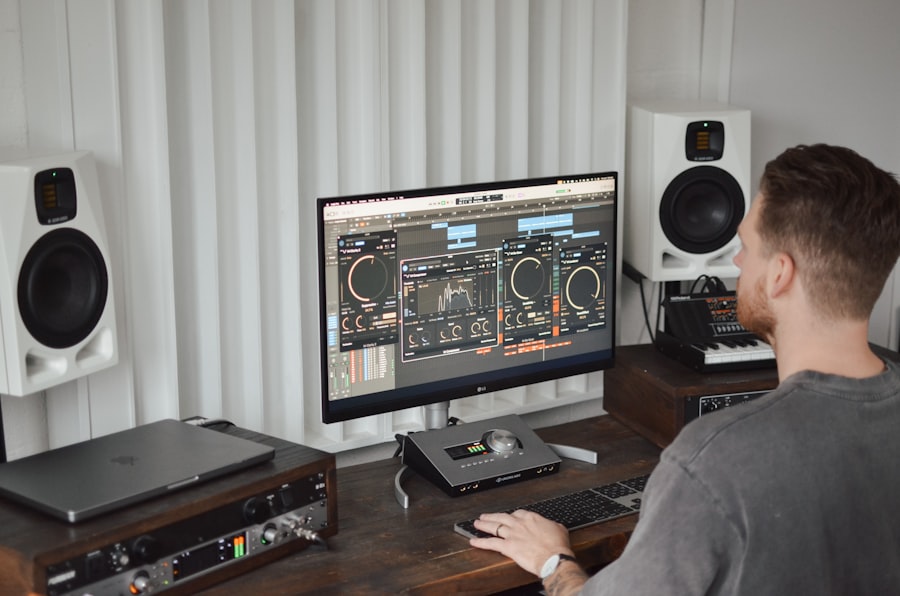The term “Hallelujah Midi” refers to a specific type of MIDI file that captures the essence of the song “Hallelujah,” originally composed by Leonard Cohen. This song has been covered by numerous artists, each bringing their unique interpretation to the piece. The MIDI format allows for a digital representation of music, enabling musicians and producers to manipulate the song’s elements with precision.
MIDI files contain information about the notes, rhythms, and instrumentation, but they do not include actual audio recordings. This makes them incredibly versatile for various applications, from live performances to studio recordings. MIDI files are particularly valuable in the context of “Hallelujah” because they allow musicians to explore different arrangements and styles.
For instance, a MIDI file can be used to create a piano solo version of the song, a full orchestral arrangement, or even a contemporary electronic remix. The flexibility of MIDI means that musicians can experiment with tempo, key, and instrumentation without the constraints of traditional audio recordings. This adaptability has contributed to the enduring popularity of “Hallelujah” across genres and generations, making it a staple in both worship settings and secular performances.
How to Use Hallelujah Midi
Using Hallelujah MIDI files can be an enriching experience for musicians and producers alike. The first step in utilizing these files is to load them into a Digital Audio Workstation (DAW). Popular DAWs such as Ableton Live, Logic Pro, and FL Studio support MIDI files and provide a platform for editing and arranging music.
Once the MIDI file is imported, users can assign different virtual instruments to each track within the file. For example, one might choose a grand piano sound for the melody while layering strings or synth pads for harmony. After assigning instruments, musicians can begin to manipulate the MIDI data to suit their creative vision.
This could involve changing the tempo to create a more upbeat version of “Hallelujah” or transposing the key to better fit a vocalist’s range. Additionally, MIDI allows for intricate editing of note velocities and durations, enabling users to add expressive nuances that enhance the emotional impact of the piece. For instance, one might choose to emphasize certain notes by increasing their velocity or adding subtle variations in timing to create a more human feel.
Finding the Best Hallelujah Midi Files

Locating high-quality Hallelujah MIDI files can significantly enhance your musical projects. Numerous online platforms offer MIDI files for purchase or free download, but not all sources provide files that are well-constructed or musically accurate. Websites like MIDIWorld, FreeMidi.org, and even specialized forums dedicated to music production often feature user-generated content that can be both useful and inspiring.
When searching for MIDI files, it’s essential to consider the reputation of the source and the quality of the files offered. In addition to general MIDI repositories, many music production communities on social media platforms and forums share their own arrangements of popular songs like “Hallelujah.” Engaging with these communities can lead to discovering unique interpretations that may not be available on mainstream sites. Furthermore, some musicians offer their MIDI files as part of instructional content, providing not only the file but also insights into their arrangement techniques.
This dual benefit can be invaluable for those looking to learn while they create.
Tips for Customizing Hallelujah Midi
| Tip | Description |
|---|---|
| Change tempo | Adjust the tempo of the midi to fit your desired speed |
| Modify instruments | Experiment with different instrument sounds to customize the arrangement |
| Transpose | Change the key of the midi to match the vocal range or preferred key |
| Add effects | Apply reverb, delay, or other effects to enhance the midi playback |
Customizing Hallelujah MIDI files can transform a standard arrangement into something uniquely personal. One effective method is to experiment with different instrumentation. While the original song is often performed with piano and vocals, adding instruments like guitar, strings, or even electronic elements can create a fresh take on the classic piece.
For example, layering an acoustic guitar track beneath the piano can add warmth and depth, while synthesizers can introduce a modern twist. Another approach to customization involves altering the structure of the song itself. Musicians can rearrange sections, extend certain parts for dramatic effect, or even incorporate improvisational solos that showcase their individual style.
For instance, extending the bridge with a guitar solo can provide an opportunity for expression while maintaining the emotional core of “Hallelujah.” Additionally, adjusting dynamics throughout the piece—such as building intensity during the chorus—can enhance its overall impact and engage listeners more effectively.
Hallelujah Midi: Frequently Asked Questions
Many musicians have questions about using Hallelujah MIDI files effectively. One common inquiry is whether these files are suitable for live performances. The answer is yes; many performers use MIDI files as backing tracks during live shows.
By routing MIDI data through a software instrument or hardware synthesizer, musicians can create rich soundscapes that complement their live playing. However, it’s crucial to ensure that all necessary equipment is set up correctly before performing to avoid technical issues. Another frequently asked question revolves around licensing and copyright concerns when using MIDI files.
While MIDI files themselves do not contain audio recordings and are generally considered less restrictive in terms of copyright, it’s essential to be aware of the original song’s copyright status. For commercial use or public performances, obtaining proper licensing may still be necessary. Musicians should always check the terms associated with any MIDI file they download or purchase to ensure compliance with copyright laws.
The Future of Hallelujah Midi

Immersive Music Experiences
Moreover, as virtual reality (VR) and augmented reality (AR) technologies become more integrated into music experiences, we may see innovative ways to perform and interact with MIDI files in immersive environments. Imagine a scenario where musicians can collaborate in real-time within a virtual space, manipulating Hallelujah MIDI files together while experiencing a shared digital stage.
Collaboration and Creative Freedom
This potential for collaboration could redefine how music is created and experienced in the future. In conclusion, Hallelujah MIDI files represent a powerful tool for musicians seeking to explore one of the most beloved songs in contemporary music history.
Staying Ahead in Music Technology
By understanding how to use these files effectively, finding high-quality sources, customizing arrangements, and staying informed about future developments in music technology, artists can continue to breathe new life into this timeless piece while expressing their unique artistic voices.


